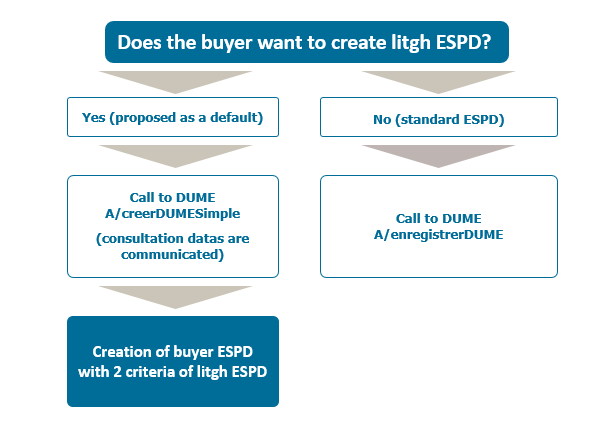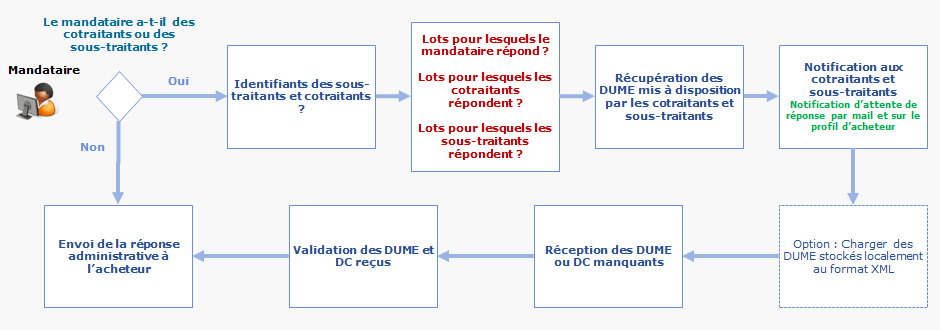Objective of the document
This part aims to putting implementation methods which are recommended by AIFE forward.
There are three possible uses of the ESPD.
1. Standard ESPD
2. Light ESPD
This kind of ESPD is possible if only the buyer accepted to use ligth ESPD. If the buyer accept, the economic operator must have to inform only his turnover and his number.
In technical point of view, there is a special call for ligth ESPD with the operation "creerDumeSimple".
Ligth ESPD process for buyer :

Light ESDP process for economic operator :

3. « Alpha » ESPD
The elements of this part present the good general practises recommended by the AIFE.
1. Good practices
- You should pass by ESPD service to call API entreprise data to limit the impact of updates and new services opening
- The only one dematerialized ESPD official format is XML. The PDF is only a copy. It is better to don't ask at economic operator to sign with electronic signature the ESPD
- Pass buyer and economic operator ESPD on to ESPD service (even EO ESPD which are realised outside buyer profile)
- Offer ESPD model (according to procedure, market ...) based on ESPD previously produced
- Tell at the buyer that if he doesn't want to create an ESPD, the buyer profile can create one based one procedure informations, and propose it at economic operator
- Focus on unit update when you should updating metadata
- Propose to economic operators to take note of exclusion criteria and give them the possibility to modify
- Retrieve ESPD by their Id to benefit other ESPD which are not created on buyer profile but present in ESPD service
- Use AIFE wording file
2. Illustrated examples of good practice to follow

In the context of buyer ESPD implementation, the AIFE recommends to publishers that they respect the principles expressed below. The aim of those principles is to simplify the use and visualization of the functionalities offered by the ESPD as much as possible.
In part III, pertaining to the exclusion criteria, it is recommended to make all the criteria uncheckable. Those criteria are all mandatory in French law and are indispensable prerequisites to an economic operator's participation to a procurement contract.
 In part IV, pertaining to the selection criteria, it is recommended to publishers that they select, by default, the answer "yes" to the question "Souhaitez-vous utiliser les critères de sélection A à D ?" ("Do you wish to use the selection criteria going from A to D?"). This encourages buyers to fill out selection criteria that are specific to their call for tenders. In order to minimize the use of the "alpha" checkbox, it is recommended that the buyer profile indicate that the criteria selection enables to benefit from the ESPDs' analytical function during the studying of the bids phase.
In part IV, pertaining to the selection criteria, it is recommended to publishers that they select, by default, the answer "yes" to the question "Souhaitez-vous utiliser les critères de sélection A à D ?" ("Do you wish to use the selection criteria going from A to D?"). This encourages buyers to fill out selection criteria that are specific to their call for tenders. In order to minimize the use of the "alpha" checkbox, it is recommended that the buyer profile indicate that the criteria selection enables to benefit from the ESPDs' analytical function during the studying of the bids phase.
In the case where the buyer still checks "no" to the use of the selection criteria, it is recommended to use tooltips in order to indicate that the criteria applicable to the call for tenders are available in the tender rules and that this use of the ESPD is not recommended.
 In order to shorten the criteria selection phase in part IV as much as possible, buyer profiles are recommended to offer ESPD "templates" according to contract typology. For example, if the buyer indicates that he or she wishes to create a "works" contract ESPD, the selection criteria pertaining to "supply" and "service" contracts will not be displayed.
In order to shorten the criteria selection phase in part IV as much as possible, buyer profiles are recommended to offer ESPD "templates" according to contract typology. For example, if the buyer indicates that he or she wishes to create a "works" contract ESPD, the selection criteria pertaining to "supply" and "service" contracts will not be displayed.
In the context of economic operator ESPD implementation, the the AIFE recommends to publishers that they respect the principles expressed below. The aim of those principles is to simplify the use and visualization of the functionalities offered by the ESPD as much as possible.
In part III, pertaining to the exclusion criteria, it is recommended to answer "no" by default to the question "L’ensemble des motifs de la partie III, dans le droit national français, sont obligatoires, souhaitez-vous en prendre connaissance ?" ("All of the criteria in part III are mandatory in French national law, do you wish to see them?"). This makes for a cleaner ESPD design. If the economic operator wishes to visualize the selection criteria, he or she can still select "yes".
 In part IV, pertaining to the selection criteria, there are three possibilities:
In part IV, pertaining to the selection criteria, there are three possibilities:
1/ The economic operator responds to a buyer ESPD. In this case of use, it is appropriate for the buyer profile to only show the criteria set by the buyer to the economic operator. The "fusionnerDUME" ("mergeESPD") API, provided by the AIFE, enables to create an economic operator ESPD based on the ESPD made by the buyer.
2/ The economic operator responds without a buyer ESPD. In this case, the buyer profile is advised to simplify the entry of a new ESPD as much as possible by prefilling the information with the API Entreprise ("Company API") and the tender data and then by creating ESPD "templates" according to the contract's typology.
3/ The economic operator makes an economic operator ESPD based on the criteria present in the tender rules. This case of use can only exist if the buyer requested from the economic operator that he or she answer the selection criteria formulated in the tender rules. (This functionality has to be implemented but should not be highlighted because its use is discouraged). When the economic operator makes a response ESPD, it is recommended to indicate with a tooltip that the applicable criteria are in the tender rules.
The aim of this sub-section is to:
1/ Convey the good practices to adopt regarding the co-contracting and sub-contracting's management when implementing the ESPD in your buyer profile.
2/ Offer you kinematics models that will allow you to implement user itineraries for economic operators who choose to answer as a consortium on your buyer profiles.
1. Kinematics Synthesis
- An "automatic" mode in which each operator must only indicate the identifier (mainly the SIRET) of the agent (or its main contractor) and the '' identifier of any subcontractors or co-contractors so that all of the ESPD goes back to the agent. This operating mode admits that any operator in the group initiates the response first. This mode is based solely on the operator identifier and on the consultation identification.
- An "intermediate" mode in which the agent notifies the other operators in the grouping that he is awaiting a response from them. The response is sent when all the ESPDs are received by the agent.
- A "manual" mode in which each operator sends to the agent ESPDs generated outside the buyer profile and stored locally in XML format. Upon receipt, these ESPDs will be entered by the agent in the administrative response on the buyer profile.
These three modes are not exclusive. Indeed, the agent can decide to respond to a consultation, recover ESPD already made available by its subcontractors or co-contractors, notify those who have not sent and load ESPD stored locally in XML (sent beforehand by d 'other operators). These three operating modes do not exclude the use of DC type documents for economic operators who wish to do so.
2. The economic operator journey
1 / If the economic operator is an agent, he must respond to the consultation. The agent is the person in charge of grouping the ESPDs of all the co-contractors and subcontractors involved in the grouping and submits a global response to the buyer.
2 / If the economic operator is a co-contractor or a subcontractor, he participates in the group response. In this case, the operator is responsible for completing his ESPD and that of any subcontractors and must submit them to the agent.

3. The mandatory journey

4. The co-contracting and subcontracting journey
The main contractor is an economic operator who has used a subcontractor in the context of a public contract. If he is a subcontractor himself, he is called the main contractor of the indirect subcontractor.
For the sake of simplicity, we will name the main contractor, when necessary, any member of the grouping with a subcontractor, regardless of their status elsewhere.
The subcontractor is a company that sees part of the contract subcontracted by the contractor (then called the main contractor).

Last Update: July 13, 2021



